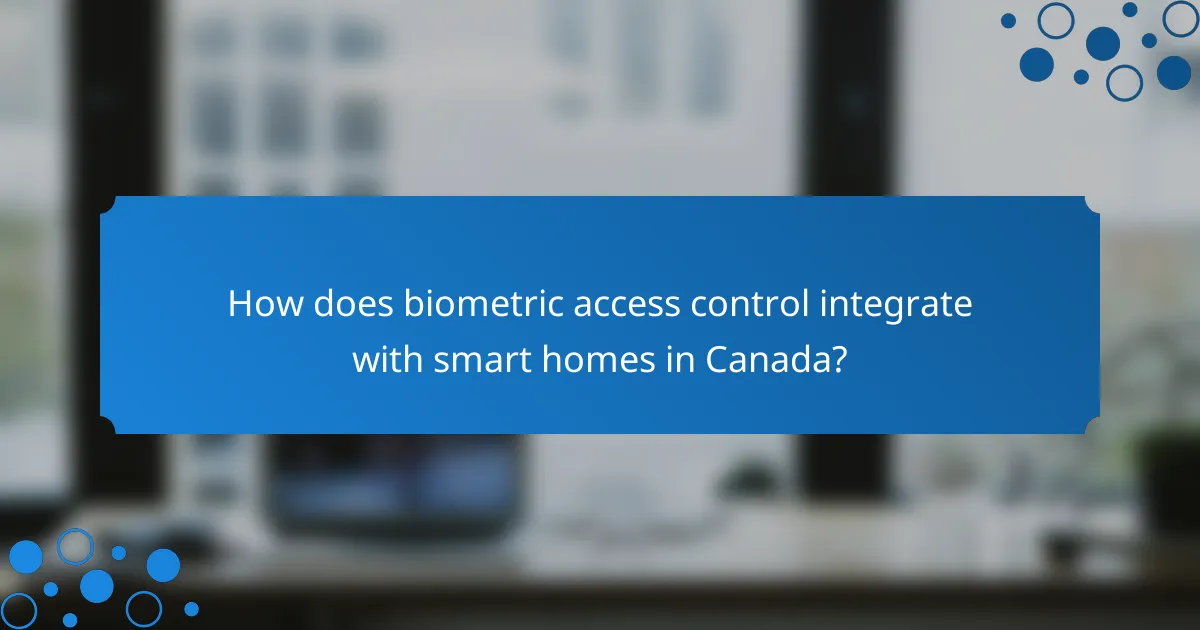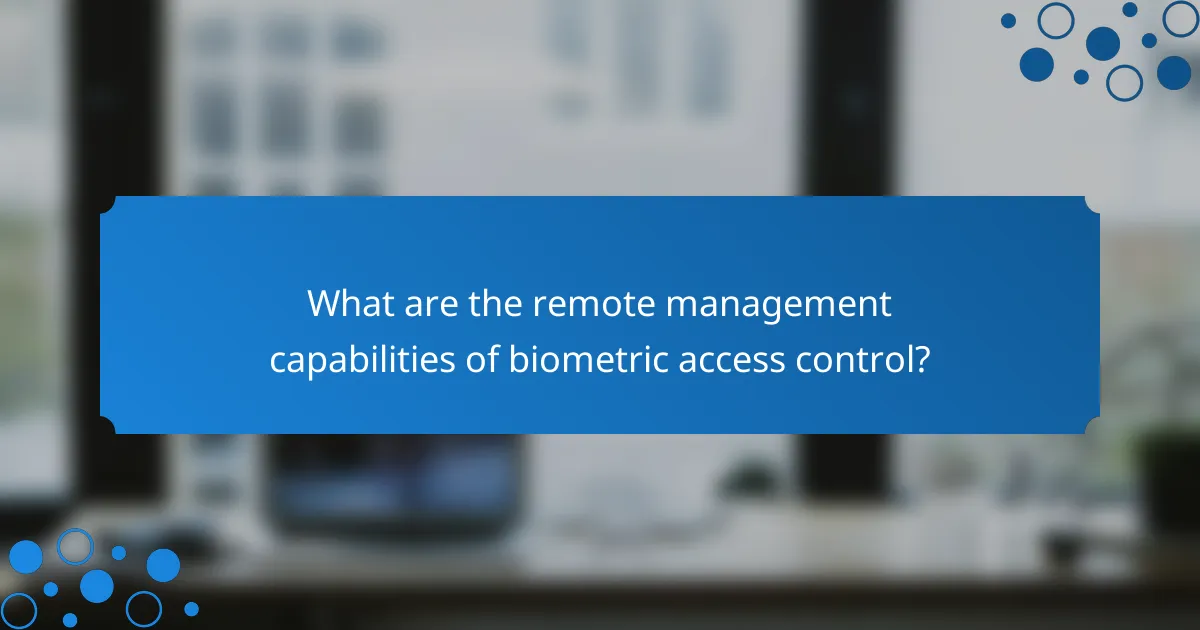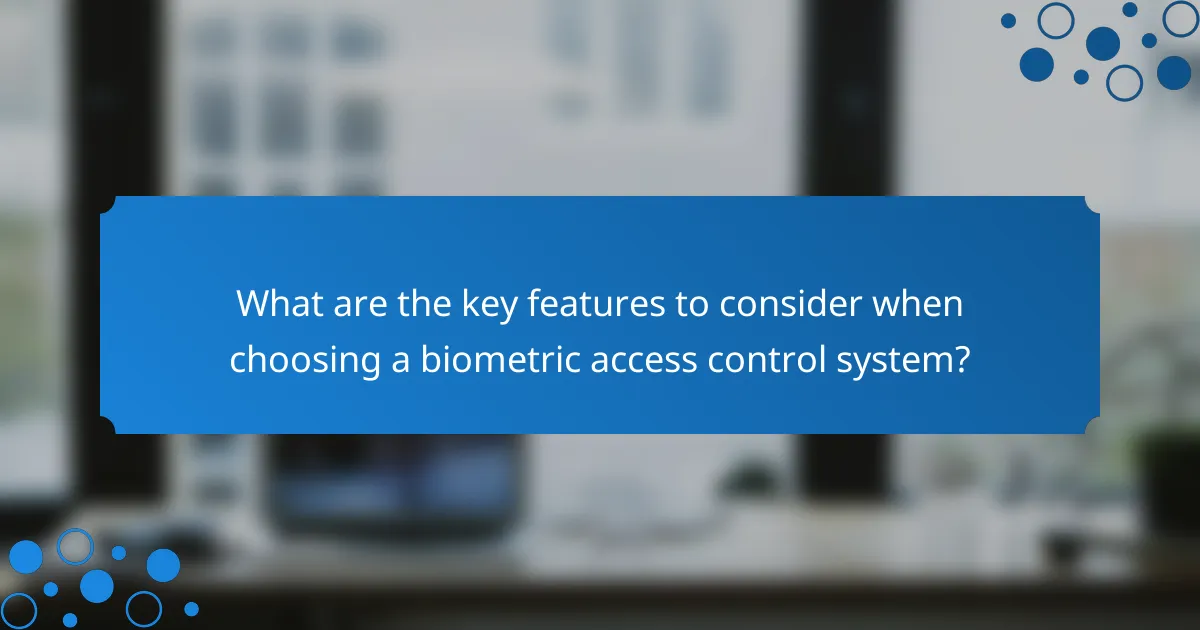Biometric access control systems revolutionize smart home security by utilizing unique physical traits, such as fingerprints or facial recognition, to grant access. These advanced systems enable remote management and provide users with comprehensive control over their home security, ensuring tailored access and efficient user management.

How does biometric access control integrate with smart homes in Canada?
Biometric access control systems enhance smart home integration in Canada by allowing users to unlock doors and manage security through unique physical traits like fingerprints or facial recognition. This technology streamlines home security, providing remote management capabilities and user control over access points.
Compatibility with smart home platforms
Biometric access control systems are designed to work seamlessly with popular smart home platforms such as Google Home, Amazon Alexa, and Apple HomeKit. This compatibility enables users to manage their biometric devices alongside other smart home gadgets, creating a unified control experience.
When selecting a biometric device, ensure it supports the specific smart home ecosystem you use. Many devices offer integration features that allow for easy setup and management through a single app, simplifying user experience.
Examples of biometric devices
Common biometric devices for smart homes include fingerprint door locks, facial recognition cameras, and smart doorbells with biometric features. Brands like August, Yale, and Ring offer products that incorporate these technologies, providing various options for homeowners.
For instance, a fingerprint door lock can be programmed to recognize multiple users, allowing family members or trusted guests access without the need for keys. Similarly, smart doorbells with facial recognition can alert homeowners when familiar faces approach, enhancing security and convenience.
Benefits of integration
Integrating biometric access control into smart homes offers numerous benefits, including enhanced security, convenience, and remote management. Biometric systems reduce the risk of unauthorized access since they rely on unique physical traits that are difficult to replicate.
Additionally, users can manage access remotely, allowing them to grant entry to visitors even when they are not home. This feature is particularly useful for homeowners who travel frequently or want to monitor their property while away.

What are the remote management capabilities of biometric access control?
Biometric access control systems offer robust remote management capabilities that allow users to monitor and control access to their properties from anywhere. These systems typically integrate with smart home devices, providing a seamless experience for managing security and user permissions.
Mobile app functionalities
Mobile apps for biometric access control enable users to manage entry points directly from their smartphones. Common functionalities include granting or revoking access permissions, viewing access logs, and receiving real-time alerts about entry attempts.
Many apps also support user-friendly interfaces that allow for easy navigation and quick adjustments to settings. Users can often customize notifications and set schedules for when access is permitted, enhancing security and convenience.
Real-time monitoring features
Real-time monitoring features in biometric access control systems provide instant updates on who enters or exits a property. Users can receive alerts via their mobile devices whenever someone accesses the premises, ensuring they are always informed.
Some systems include video feeds or snapshots taken during access events, allowing users to visually verify entries. This feature is particularly useful for monitoring high-traffic areas or ensuring that only authorized individuals are granted access.
Remote access control
Remote access control allows users to manage entry points from virtually anywhere, using their mobile devices or computers. This capability is essential for homeowners who travel frequently or manage multiple properties.
Users can unlock doors remotely, making it easy to grant access to guests or service personnel without being physically present. It’s important to ensure that the system is secure and that users regularly update their passwords to prevent unauthorized access.

How can users control biometric access systems?
Users can control biometric access systems through various management options, customizable settings, and monitoring features. These systems allow for efficient user management and tailored access, enhancing security in smart homes.
User management options
User management options in biometric access systems typically include adding, removing, or modifying user profiles. Administrators can easily grant or revoke access rights, ensuring that only authorized individuals can enter specific areas.
Many systems allow for multiple user roles, such as administrators, guests, and regular users, each with different access permissions. This flexibility helps maintain security while accommodating various users’ needs.
Customizable access levels
Customizable access levels enable users to define who can access certain areas based on their roles or needs. For instance, a homeowner might grant full access to family members while providing limited access to service personnel.
Some systems allow for time-based access, where users can set specific hours during which access is permitted. This feature is particularly useful for managing visitors or service providers, ensuring they can only enter when needed.
Audit trails and logs
Audit trails and logs are essential for tracking access events in biometric systems. These logs provide a detailed record of who accessed the system, when, and where, which is crucial for security and accountability.
Regularly reviewing these logs can help identify unauthorized access attempts or unusual patterns, allowing users to respond promptly. Many systems offer alerts for suspicious activities, enhancing overall security management.

What are the key features to consider when choosing a biometric access control system?
When selecting a biometric access control system, consider integration capabilities, scalability, and security protocols. These features ensure that the system meets your current needs while allowing for future upgrades and maintaining robust security standards.
Integration capabilities
Integration capabilities refer to how well the biometric access control system can work with existing smart home devices and security systems. Look for systems that can seamlessly connect with alarms, cameras, and home automation platforms to create a cohesive security environment.
For instance, a system that integrates with smart locks and video doorbells can provide real-time alerts and remote access management. Ensure compatibility with popular platforms like Amazon Alexa or Google Home for enhanced user control.
Scalability for future needs
Scalability is crucial as it determines how easily you can expand your biometric access control system as your needs change. Choose a system that allows for the addition of new users, devices, or features without significant upgrades or replacements.
For example, if you start with a single door and later want to add multiple entry points, the system should accommodate this growth. Look for modular systems that offer flexible options for future enhancements.
Security protocols
Security protocols are essential for protecting sensitive biometric data and ensuring system integrity. Opt for systems that utilize encryption and comply with recognized standards, such as ISO/IEC 27001, to safeguard user information.
Additionally, consider features like two-factor authentication and regular software updates to enhance security. A system with robust security measures will help prevent unauthorized access and data breaches, providing peace of mind for users.

What are the benefits of using biometric access control in Canadian homes?
Biometric access control systems offer significant advantages for Canadian homes, primarily enhancing security and user convenience. These systems utilize unique biological traits, such as fingerprints or facial recognition, to grant access, making unauthorized entry extremely difficult.
Enhanced security measures
Biometric access control provides robust security by relying on unique physical characteristics that are difficult to replicate. Unlike traditional keys or passwords, which can be lost or stolen, biometric traits are inherently tied to the individual, significantly reducing the risk of unauthorized access.
In Canada, many biometric systems comply with privacy regulations, ensuring that personal data is securely stored and processed. Homeowners should look for systems that offer encryption and adhere to standards like the Personal Information Protection and Electronic Documents Act (PIPEDA) to protect their data.
Convenience for users
Biometric systems streamline the access process, allowing users to enter their homes quickly without fumbling for keys or remembering passwords. This is particularly beneficial for families, as multiple users can be easily registered, enabling seamless access for everyone.
Remote management features are often included, allowing homeowners to monitor access and manage permissions through a smartphone app. This means you can grant access to guests or service personnel even when you’re not home, enhancing both convenience and security.
